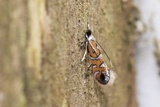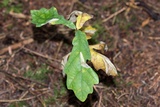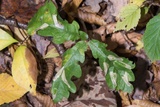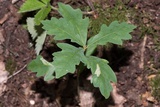Phyllonorycter lautella (Zeller, 1846) Species
Last modified: Feb. 27, 2021, 4:42 p.m.
A rather common species in Belgium.
Details
- Classification
- Family: Gracillariidae > Subfamily: Lithocolletinae > Genus: Phyllonorycter > Species: Phyllonorycter lautella
- Vernacular names
- Prachteikenvouwmot (NL), Fiery oak midget (EN)
- First mention in Belgium
- De Fré Ch. 1858. Catalogue des Microlépidoptères de la Belgique. — Annales de la Société entomologique belge 2: 45–162. On page 157. view page
- Status
-
Native
Distribution
Imago
Head black; forewing ground colour reddish-brown; white pattern consisting of a short basal line, a small patch near the base at the dorum, three (sometimes four) costal and two dorsal striae; the first striae can sometimes merge in the middle to form a transversal band; a white and a black spot in the apical area.
Mine
Rather long (max. 25 mm), whitish mines on the underside of a leaf, most of the time between two secondary veins; one strong longitudinal fold in the middle. The dark frass is concentrated in one corner of the mine.
See also gracillariidae.net and bladmineerders.be.
Cocoon/pupa
White cocoon, pupa dark brown to black.
Bionomics
The species has a preference for seedlings or very young trees up to 1 m high. Quite often many mines are present on one leaf, causing the leaf to contort. Pupation in a white cocoon inside the mine. The cocoon of the summer generation is rather flimsy, that of the autumn generation is much tougher and strong. The frass is spun together at the other side of the mine. The species hibernates in the pupal stage, within the fallen leaf, between leaf litter on the ground. The pupal skin protrudes from the mine after emergence of the adult.
Adults rest during daytime on tree trunk or in the foliage. They become active towards dusk and come to light.
Flight periods
Two generations a year: April–May and July–August.
Observed on
- Host plant (species):
- Quercus robur, Quercus petraea and Quercus rubra
- Host plant (genera):
- Quercus
The species has a preference for Quercus robur, but it has also been recorded from Quercus petraea and even Q. rubra.
Habitat
The species prefers hot areas on sandy biotopes, also open places in forests.




